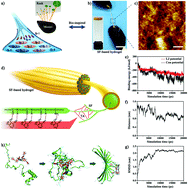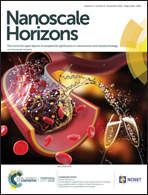A silk-based sealant with tough adhesion for instant hemostasis of bleeding tissues†
Abstract
Marine mussels harness catechol-rich foot proteins with hierarchically assembled nanostructures to achieve robust adhesion in the dynamic underwater environment. Herein, mimicking the chemical composition and hierarchical nanostructure of mussel foot proteins, a silk-based sealant (named SFT) with superior wet adhesion and instant hemostasis was developed by introducing tannic acid (TA) into silk fibroin (SF). The presence of TA containing abundant phenolic moieties triggered the conformational transition of SF from random coil to β-sheet and the hierarchical assembly of nanofibrillar structures, imparting SFT with high intrinsic toughness (123.1 kJ m−3). The phenolic moiety, with strong binding affinity to nucleophiles in tissue biomolecules, also endowed SFT with tough adhesion to wet tissues (strength ≈134.1 kPa) even in the presence of blood and robust tissue motions (e.g., bleeding heart) and exhibited instant hemostatic capability (within 30 s). Given the unprecedented combination of tough adhesion and instant homeostasis, the engineered SFT can fulfil unmet challenges and serve as a promising surgical sealant for suturelessly sealing ruptured tissues in wet and dynamic biological environments.

- This article is part of the themed collections: Advisory Board research selection and Nanoscale Horizons Most Popular Articles


 Please wait while we load your content...
Please wait while we load your content...